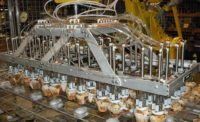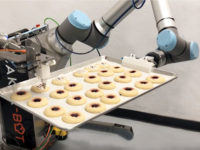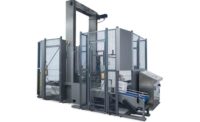Automation is the key element in the evolution of product handling equipment often seen in the snack and bakery market. Cartoners, case packers, palletizers and similar equipment increase productivity while handling a wide range of packaging styles.
Equipment manufacturers see a trend toward flexibility. “Customers want to run their big-box store SKUs and their club store SKUs on the same machine. This has resulted in applications where you need to run chipboard and corrugated cartons on the same machine,” says Eric Langen, vice president of sales and marketing, AFA Systems, Brampton, Ontario.
A wide range of SKUs results in many different pack patterns. This means end-of-line packaging machinery should accommodate a wide range of sizes. “We are seeing more complicated carton types, such as hanger-tab-style, window-style and auto-bottom. These styles are developed by end users to differentiate their product lines. All these trends have resulted in more complicated systems in terms of cartoning, case packing and palletizing,” Langen says.
More automation
End-of-arm tooling (EOAT) for picking and handling food products and packages continues to advance in terms of innovation, sanitation and performance. New designs permit rapid handling of difficult shapes or profiles without damaging the product. Quick-change features are becoming a key facet of the tooling design.
“The recent perfection of automatic tool-changing technology makes it easy for us to design systems with different end-of-arm tools that can handle a wide variety of products with the same robotic solution,” says Rick Hoskins, president, Colborne Foodbotics LLC, Lake Forest, IL. He notes that improved human-machine interfaces (HMIs) allow for quick changeovers to handle different products.
“There also is a tangible migration from fixed automation to robotic automation, due to factors such as cost, redeployment capabilities, ease of programming, safety and failure rates. New software safety ratings for robots now permit the footprint of the cell to be minimized, saving floor space,” says Jack Uhl, regional sales manager of consumer products, Yaskawa America Inc., Motoman Robotics, Miamisburg, OH.
The degree of automation in packaging is increasing to address requirements related to faster throughput. “Vision systems and product tracking on conveyors, coupled with high-performance motion control, is improving product quality and reducing production waste,” says Binu Thomas, business development, packaging industry, Siemens USA, Norcross, GA.
Thanks to developments in robotics and robotic tooling, new packaging systems can handle items such as fresh-baked brownies, snack cakes, bagels and other items, without damaging the product, at speeds that provide an attractive return on investment, according to Carl Vause, CEO, Soft Robotics, Cambridge, MA. Current examples include tray loading of fresh dough, loading snack cakes into flow wrapping systems, and robotic loading of bagged bread products into baskets.
Some aspects of existing operations can hold back automation progress. “For example, bakery/snack producers that use low-cost trays to package products may not be able to automate their tray de-nesting operation because inexpensive trays don’t have a rigid flange. An actual person still needs to pull the trays apart. Upgrading to a higher quality tray enables the de-nesting operation to become automated,” says Casey Di Chiria, international sales manager, MGS Machine, Maple Grove, MN.
Something new
The latest product handling systems feature modular designs and sophisticated electronics. For example, A-B-C Packaging Machine Corp., Tarpon Springs, FL, recently introduced a robotic packer and palletizer series. The systems are modular in design, which allows maximum flexibility and easy upgrades. “The electronics packages monitor and control all operations, configuration setup and changeover. Operator interfaces utilize simple graphical displays for ease of operation,” says Bryan Sinicrope, vice president of sales and marketing.
AFA Systems has developed a new cartoning system, the Intermittent Motion Autoload Cartoner (HD-IMA). It offers high-speed, intermittent-motion operation of up to 100 cartons per minute, and the flexibility to run both chipboard and corrugated cartons. In addition, the system utilizes dual Delta 3 robots to ensure flexibility with multi-pack cartons, as well as high-speed operation of up to 600 products per minute.
Soft Robotics is working with producers to solve primary product handling challenges. “We offer systems that package fresh, unfrozen dough products and load chocolates into vacuum formed trays, as well as systems for primary handing of frosted snack cakes. This technology enables bakery/snack producers to fill the automation gap between the oven and case-packing systems,” Vause says. “A key feature is that the system is plug-and-play into any standard commercial robot. We use our patented Soft Robotics technology to enable these systems to interact with objects of varying size, shape and weight, without damaging the product, and we do this without sophisticated electronics or software programming.”
Delkor has introduced a robotic loader within its C Series. It can load larger products at high speeds into cartons, shippers or retail-ready packaging (RRP) designs. The modular loader incorporates a Fanuc 710 robot with a dual-servo collation system to group incoming product. 3D-printed or conventional tooling allows the loader to accept a variety of products.
Rehrig Pacific Co. recently introduced a prototype of a new bakery tray stacker, the Stack-King. It’s designed to safely provide maximum cube utilization for bakery distribution by assisting with up/down stacking and tray sortation of both full and empty trays. The prototype was designed in response to customers who identified the need to maximize product cube utilization and eliminate wasted vertical space during transport.
Yaskawa America has developed the MLX200 robot control, which allows Yaskawa robots to be easily programmed via existing Rockwell PLCs. This eliminates the need for two different processors and program languages in a production line. It also creates a deeper technical support network among end users. Another innovation, the new Motoman HC10 packaging robot, safely works in collaboration with a human in a shared workspace, while permitting simple, hand-directed teaching of new picking routines.
Intelligrated recently introduced the Alvey 891i palletizer, which offers an updated, user-friendly design, the company reports. Suitable for single- and multi-line operations, the row-forming palletizer manages intricate stacking patterns and handles various types of packaging. It also incorporates features for improved safety, ease of use and maintenance.
Looking ahead
Experts see even more technological advances in the near future. “I believe we will see more systems that perform multiple operations on a single unit,” says Langen. “One example is the AFA Systems TR-CPP Transrector Series Combination Case Packer Palletizer, which features case packing and palletizing on one monobloc frame. The system reduces machinery footprint and improves troubleshooting and changeover capability.”
Clearly, these machines are getting smarter. One example, notes Mike Brewster, director of sales and marketing, Schneider Packaging Equipment, Brewerton, NY, is Intelligent Illumination, a feature that he sees becoming a standard in the industry. It pinpoints the location of any area on a machine that affects operating efficiency—low supply (tape, glue, etc.) or something directly affecting production and then tells the operator that the machine needs attention. In effect, it helps operators who may or may not be in the vicinity of the equipment to address the supply issue.
Any means of increasing production efficiency and reducing downtime will always be valued by high-volume snack producers and bakers.








